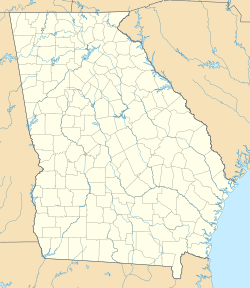St. Catherines Island facts for kids
St. Catherines Island is one of the beautiful Golden Isles found along the coast of the U.S. state of Georgia. It's located about 20 miles (32 km) south of Savannah in Liberty County. This island stretches about 10 miles (16 km) long and is between 1 to 3 miles (1.6 to 4.8 km) wide. It sits between St. Catherine's Sound and Sapelo Sound.
More than half of the island's 14,640 acres (59 km²) are covered by tidal marshes and wetlands. About half of the island is made up of salt marshes, while a quarter is covered in woods. The island also boasts "fine" beaches. St. Catherines Island is privately owned by the Saint Catherines Island Foundation. Because it's private, it's not open to the public, except for the beach area below the average high tide line.
Contents
Island History: A Look Back
St. Catherines Island has a very long history, with people living there for at least 4,000 years. By 1576, it was a settlement for the Guale people. It also became the location of the first Spanish outpost in Georgia.
Early Spanish Settlements
By 1587, St. Catherines Island was the most northern permanent Spanish outpost along the Atlantic Coast. The Spanish tried to set up colonies further north, even reaching Chesapeake Bay, but these didn't last more than a year or two. During the 1600s, a mission called Santa Catalina de Guale was built on the island. From 1602 to 1680, this mission was the main center for the Guale missionary area of Spanish Florida.
Uncovering Ancient Life
Scientists like David Hurst Thomas have studied the Spanish period history on St. Catherines Island through archaeology. Currently, he and Matthew C. Sanger are leading excavations at a special place called a shell ring on the island. These digs have found copper objects that are very similar to those found at ancient hunter-gatherer sites near the Great Lakes. This suggests that traders might have traveled all the way from the Midwest to St. Catherines Island a long time ago.
Another scientist, Clark Spencer Larsen, has worked closely with David Hurst Thomas. They have studied the bones and cultural history of the people who lived on St. Catherines Island and in the wider La Florida region. This field is called bioarchaeology, and it helps us understand how people lived and changed over time.
Plantation Life and the Civil War
In 1766, Button Gwinnett, who was one of the people who signed the Declaration of Independence, leased the island. For almost a century, the island was run as a large farm, or plantation. This continued until the Civil War ended.
Freedom and Challenges
During the Civil War, the island was given to the Freedmen's Bureau by General Sherman through his Special Field Orders No. 15. On the island, an agent named Tunis Campbell helped set up a government and schools for formerly enslaved people. He also created a group of armed citizens to help keep white people from interfering with the islanders' new freedom. However, in the fall of 1865, the U.S. Congress canceled Sherman's orders. African-American Union soldiers were then sent to remove Campbell from the island, as he refused to leave.
Natural Disasters and New Beginnings
The 1893 Sea Islands Hurricane caused terrible damage to St. Catherines Island. Seawater swept across the entire island. Only one person who stayed on the island survived, and all the buildings were destroyed.
In 1943, Edward John Noble bought the island. He used it to raise Angus cattle. Ten years after he passed away in 1958, the island was given to the Edward J. Noble Foundation.
The Island Today: Conservation and Research
Today, the St. Catherines Island Foundation owns the island. The inner part of the island is used for good causes like science, education, and charity. The foundation works to protect natural resources, help endangered animals survive, and save historical sites. They also aim to increase human knowledge in areas like ecology (how living things interact with their environment), botany (the study of plants), zoology (the study of animals), natural history, and archaeology.
The island is actively involved in helping to conserve the ring-tailed lemur, an endangered animal. In 1969, St. Catherines Island was recognized as a National Historic Landmark. This also automatically placed it on the National Register of Historic Places, highlighting its important history.





